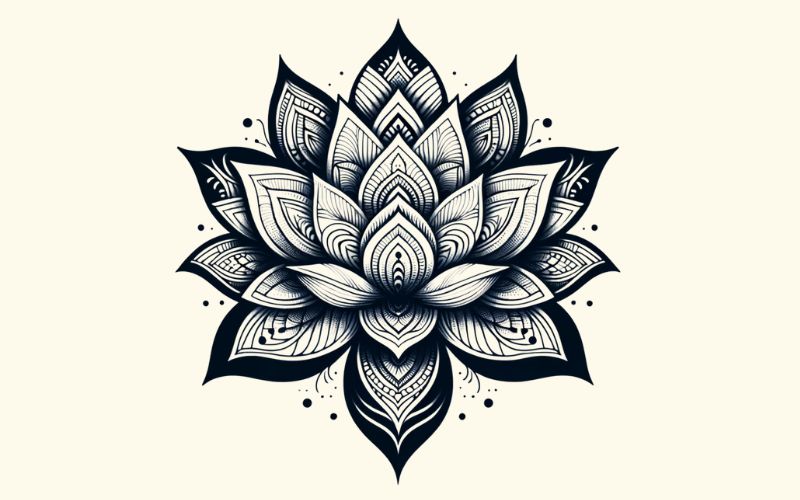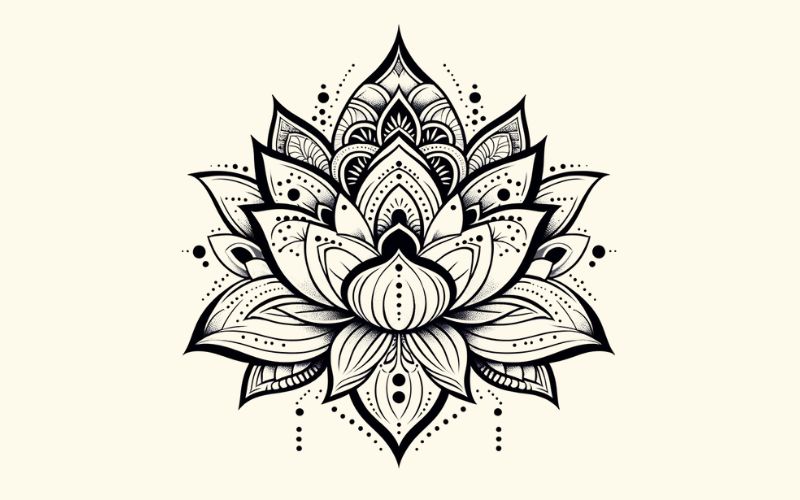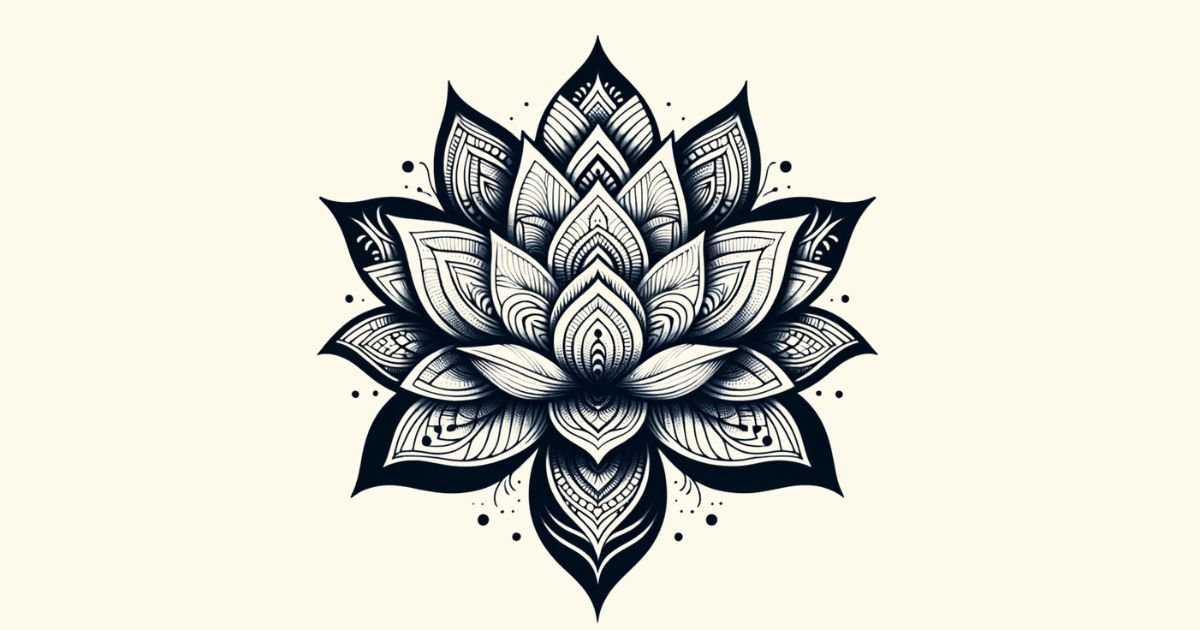
Lotus mandala tattoos represent a unique blend of beauty, spirituality, and artistry.
The lotus flower, revered for its purity and resilience, perfectly complements the mandala’s representation of the universe and spiritual growth.
Why do people choose lotus mandala tattoos? What deeper meanings lie within these intricate designs?
I’m here to guide you through the labyrinth of meanings behind the lotus mandala tattoo.
In this article, I aim to provide insights so that you will understand the intricacies of the lotus mandala tattoo meaning.
Essential Insights
- Lotus mandala tattoos blend the purity of the lotus with the universal symbolism of the mandala.
- They represent personal journeys, spiritual growth, and artistic expression.
- This article explores their rich symbolism and cultural interpretations.
This article may contain affiliate links. If you click on one of them, we might receive a small commission (at no extra cost to you). Thanks for your support to help us keep this site running!
Table of Contents
What is the Meaning of a Lotus Mandala Tattoo?
Lotus mandala tattoos symbolize personal growth and spiritual enlightenment, combining the purity of the lotus with the complexity of the universe represented in a mandala.
This concept aligns closely with the themes of strength in lotus flower tattoos, where the emphasis is on resilience and overcoming challenges.

What is a Lotus Mandala?
A lotus mandala is a spiritual and artistic symbol combining the sacred lotus flower with the geometric and cosmic representations of a mandala.
This symbol has roots in various ancient cultures and holds significant spiritual and philosophical meanings.
The lotus mandala’s history is as diverse as the cultures that cherish it.
In Hinduism and Buddhism, the lotus represents spiritual awakening, purity, and the unending cycle of life and death.

Mandalas (in Hinduism, they are call yantras), with their intricate geometric patterns, symbolize the universe, spiritual journey, and the quest for inner peace.
When combined, the lotus mandala becomes a powerful emblem of the journey towards enlightenment and the beauty of life’s continual unfolding.
This symbol’s appeal lies not just in its profound meanings but also in its artistic versatility. The lotus mandala can be depicted in countless styles, each bringing a unique interpretation and flair.
From intricate line work and dot patterns to bold colors and flowing forms, the design’s adaptability makes it a popular choice for tattoos and artistic expressions worldwide.
Lotus Mandala Facts

- Origin and Significance: The lotus mandala is steeped in ancient spiritual traditions, particularly in Hinduism and Buddhism.
- Artistic Variations: From simple line art to complex, colored designs, lotus mandalas can be adapted to various artistic styles.
- Global Appeal: The lotus mandala’s universal themes of purity, enlightenment, and the cosmos resonate across cultures.
- Personal Reflection: For many, it represents a personal journey or a significant life change.
- Popular in Meditation: Often used in meditation practices as a focus point for achieving mindfulness and inner peace.
Lotus Mandala Symbolism and Meanings

The symbolism of the lotus mandala is as varied as it is profound. It stands as an emblem of purity, spiritual awakening, and the intricate journey of life.
The lotus flower’s ability to bloom in muddy waters symbolizes overcoming adversity and finding beauty in the challenges of life. The mandala’s geometric patterns represent the cosmos, unity, and the never-ending cycle of existence.
In different cultures, the lotus mandala holds varying meanings:
- Buddhism: Here, it symbolizes the journey to enlightenment and the eightfold path.
- Hinduism: It represents creation, cosmic harmony, and the gods’ divine essence.
- Modern Interpretations: In contemporary contexts, it’s seen as a symbol of personal growth, harmony, and the balance of life.
The lotus mandala’s timeless appeal lies in its ability to merge these diverse interpretations into a singular, powerful symbol. It’s a visual representation of life’s complexity, the beauty of nature, and the human spirit’s resilience.
Lotus Mandala Spiritual and Mythological Meaning

The lotus mandala holds profound spiritual and mythological significance. In various spiritual traditions, it symbolizes key aspects of human experience and cosmic understanding.
- Buddhist Symbolism: In Buddhism, the lotus mandala is a sacred symbol of enlightenment, purity, and the universe’s interconnected nature. It represents the journey from ignorance to wisdom, mirroring the lotus flower’s growth from mud to beauty.
- Hindu Mythology: In Hindu mythology, the lotus mandala is often associated with the gods Brahma and Vishnu, symbolizing creation, spiritual awakening, and the universe’s eternal nature.
- Other Spiritual Traditions: In other spiritual beliefs, the lotus mandala can represent the cycle of life and death, the balance of the physical and spiritual, and the pursuit of inner peace and understanding.
Lotus Mandala Tattoo Meaning

In tattoo art, the lotus mandala takes on a variety of specific meanings, each adding a layer of depth and personal significance to the design.
- Journey Towards Enlightenment: Often chosen by those on a spiritual path, symbolizing their journey towards enlightenment and self-discovery.
- Resilience and Overcoming Adversity: Reflects the wearer’s strength in overcoming challenges, akin to the lotus blooming in muddy waters.
- Symbol of Harmony and Balance: Represents the quest for inner peace and balance in life’s complexities.
- Artistic Expression of Individuality: A popular choice for its aesthetic beauty and as a personal statement of individuality and artistic taste.
- Connection to Nature and the Cosmos: Serves as a reminder of one’s connection to the natural world and the larger universe.
These meanings contribute to the lotus mandala tattoo’s popularity, offering both personal significance and artistic appeal.

The 6 most Popular Lotus Mandalas and Their Meaning
- Ganesha Yantra: This Hindu symbol features Lord Ganesha, revered for removing obstacles and bringing good fortune. Depicted seated on a lotus, this yantra highlights Ganesha’s spiritual authority and the lotus’s emblem of purity and enlightenment.
- Kali Yantra: Dedicated to Goddess Kali, this yantra symbolizes strength and spiritual liberation. It features concentric circles and lotus petals centering around a bindu, representing the universe’s creation. Used in meditation, it invokes protection and the transcendence of spiritual barriers.
- Garbhadhatu Mandala: This intricate mandala is a representation of the Buddhist Womb Realm. It features numerous deities from Japanese and Chinese Buddhist traditions surrounding a central lotus. Its complexity and the multitude of fine details make it a challenging yet profound design.
- The Trident Yantra: A unique blend of tranquility and assertiveness, this yantra combines a serene lotus with a sharp trident. It embodies the dual aspects of Lord Shiva: his peaceful nature and his role as a destroyer of evil, symbolizing the coexistence of war and peace.
- Sri Yantra: The Sri Yantra is an esoteric work of art, closely resembling mandalas. It incorporates sixteen lotus petals encircling a complex arrangement of interlocking triangles. This yantra is a powerful symbol of non-duality, bridging the spiritual and material worlds.
- Nava Padma Mandala: Central to this design is a prominent lotus flower, symbolizing purity and spiritual awakening. It is commonly used in Parameshwara initiation ceremonies, emphasizing the importance of spiritual rebirth and enlightenment.
Lotus Mandala Tattoo FAQs

What Should You Consider Before Getting a Lotus Mandala Tattoo?
When considering a lotus mandala tattoo, it’s important to reflect on the design’s size, placement (e.g. popular options like finger, shoulder or back), color, and personal meaning.
Consider how the tattoo aligns with your spiritual beliefs or personal journey. It’s also crucial to choose an experienced artist who can capture the intricacy of the design.
How to Care for Your Lotus Mandala Tattoo?
Proper aftercare is essential to maintain the beauty of your lotus mandala tattoo.
This includes keeping the tattoo clean, moisturized, and protected from the sun, as well as following the specific aftercare instructions provided by your tattoo artist.
Is a Lotus Mandala Tattoo Culturally Sensitive?

While the lotus mandala is a symbol respected across various cultures, it’s important to approach it with cultural sensitivity.
Understanding the symbol’s origins and meanings can help ensure that your tattoo is respectful and meaningful.
To further explore the variety and depth of lotus tattoos, consider looking into the meaning of different colors of lotus tattoos, such as blue lotus tattoos, red lotus tattoos or black lotus tattoos, each color bringing a unique dimension to the symbolism of the lotus.
Additionally, variations like lotus flower with dots tattoos or lotus arrow tattoos offer nuanced interpretations of the lotus theme, reflecting individual stories and philosophies. There is also the Semicolon Lotus Flower tattoo that symbolizes new beginnings and mental health awareness.
Please note that the information on tattoo meanings in this blog is for general guidance only and not a substitute for professional advice. Tattoo symbolism can vary greatly, and we recommend consulting with qualified experts to understand the significance and appropriateness of any design before proceeding.

